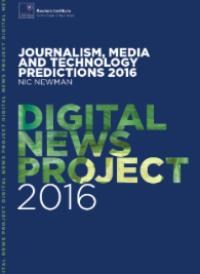- 70Shares
- Facebook31
- LinkedIn18
- E-mail4
- Buffer10
- WhatsApp7
 Robo-journalists, an ongoing battle between publishers and adblockers, bendy smartphones and social media for the workplace; the Reuters Institute is launching its new Digital News Project with a set of technology and industry predictions for the global media’s year ahead.
Robo-journalists, an ongoing battle between publishers and adblockers, bendy smartphones and social media for the workplace; the Reuters Institute is launching its new Digital News Project with a set of technology and industry predictions for the global media’s year ahead.
Journalism, Media and Technology Predictions, 2016, is a fascinating glimpse into technology and industry trends which could emerge this year, according to digital media consultant Nic Newman, a research associate at the Reuters Institute. Newman’s research includes a survey of 130 senior digital leaders across 25 countries, designed to identify and measure key industry challenges and opportunities.
“News organisations enter 2016 worrying about digital revenues in a world increasingly affected by ad-blocking and the rise of distributed content. They also know they need to keep an eye on the future with the rise of online video, new immersive storytelling and Virtual Reality,” Nic Newman said.
Online video: vertical, immersive, mobile and social
78 per cent of digital leaders surveyed said they’d be investing more in online news video this year. Exponential growth in video consumption is expected over the next few years driven by faster cheaper connectivity and mobile consumption.
Newman predicts key online video developments will include:
- Increased presence and discussion of vertical video
- Immersive storytelling, 360 and live video coverage
- More experimentation with VR around the Olympics and US election
- Traditional publishers looking to harness the talents of new, innovative creators of viralvideo content like NowThis and Vocativ
Smartphones are projected to reach around 80% of the world’s population by 2020. Newman predicts we’ll soon be using 3D touch technology on foldable, waterproof smartphones. Wireless charging will be more commonplace while increased data speeds and processing power will open up new possibilities:
- Mainstream use of personal assistants, as Facebook introduces ‘M’
- Mobile payment and ‘M-commerce’
- Growth in push notifications
- Further slow growth of wearable technology and glanceable content.
Online advertising – ad-apocalypse?
Already around 20% are using ad-blockers but the story has only just begun. Newman expects:
- Adblocking to move to mobile platforms in 2016
- Adblocking wars as publishers look to encourage readers to turn off them off
- New moves for legal protection for publishers
- Facebook, Google and Apple to remain largely immune
- More advertising in videos where it’s harder to block
- Higher quality advertising in an attempt to win audiences.
Other trends to look out for:
- The disruption of television – the video enabled internet will put pressure on broadcasters and talent
- Podcasting is on the rise. Barack Obama made his podcast debut last year, and the economics of podcasting are changing for the better.
- Social media and messaging apps – long form social content, new in-app services, enhanced security and more breaking news through chat apps are all on the cards for 2016. Newman predicts more of us will be using social tools in the workplace like Slack HipChat and Facebook at Work
Implications for publishers:
Confidence remains mixed around the business prospects for 2016. Some publishers without solid digital revenues or who relied on digital advertising are more worried about revenues than last year (22 per cent) but some with paid content or mixed business models are less (20 per cent) or equally worried (50 per cent) compared with last year.
What should publishers expect in 2016?
- Growth in crowd-funding and membership schemes
- Subscription innovation and more experiments with micropayments
- The rebirth of COMtent for a mobile age
- A focus on audience engagement analytics
- Robo-journalism – advances in pattern recognition and natural language generation mean innovation will increase in content creation as well as distribution
About the Digital News Project:
The Digital News Project examines cross-national developments in journalism and news media, combining the annual Reuters Institute Digital News Report with a range of additional publications looking at journalistic innovation and news media strategy across the world. Dr Rasmus Kleis Nielsen, RISJ Director of Research, says: “We know for a fact that the same technological trends have different implications in different countries. The Digital News Project is aimed at understanding these differences better, and at helping journalists and media decision-makers navigating a rapidly-changing environment.”
pic credit: Flickr Creative Commons: The People Speak
- 70Shares
- Facebook31
- LinkedIn18
- E-mail4
- Buffer10
- WhatsApp7
Tags: 2016, ad-blockers, predictions, publishers, Reuters Institute for the Study of Journalism, Robot journalism, smartphones, Social media, Technology
















































